For those keen to learn more about Growth Mindset, below are some Learning Videos on Growth Mindset by Dr Carol Dweck. You may also contact us to find out more.
Author Archives: Tan Teck Kim
15 Ways To Develop A Growth Mindset
So, let’s start with: What is a Growth Mindset?
Stanford psychologist Dr. Carol Dweck and author of “Mindset: The New Psychology of Success” explains how there are two types of mindsets: growth and fixed mindset.
Dr Carol Dweck describes how a growth mindset embraces challenges and views failure “not as evidence of unintelligence but as a heartening springboard for growth and for stretching our existing abilities.” While a fixed mindset grips onto the belief that intelligence and talents are static, and success is accomplished solely based on talent and little effort. Check out the summary of Growth Mindset and Fixed Mindset below
Growth Mindset vs Fixed Mindset
Growth Mindset
It’s where you want to be
- Embraces challenges
- Perseveres in spite of failure
- Believes that people can increase their intelligences of skills
- Is inspired and motivated by the success of others
- Wants to learn
- Accepts and embraces criticism
Fixed Mindset
It’s what you have
- Avoid challenges
- Gives in in the face of hardship
- Believes that intelligence and skills are what you are born with and can’t change or develop.
- Is threatened by the success of others
- Believes they know everything already
- Ignores or dismisses criticism
Growth Mindset and Fixed Mindset – a quick guide
The growth mindset definition is:
People with growth mindsets believe that skill and intelligence are something that people can develop. They believe that while people have inherent qualities and traits, success comes from constant personal development.
The fixed mindset definition is:
By contrast, those with fixed mindsets believe that talent and intelligence are something you either have or you don’t.
That is, some people are good at certain activities, and others excel in different areas. They don’t believe that practice, failure and strategy development are key to developing talent or intelligence.
What Dweck discusses is that those who do develop a high degree of talent are more often people with a growth mindset.
It works both ways.
An important finding of Dr Carol Dweck’s research is that those with growth mindsets experience greater success and skill development.
15 ways to develop a growth mindset

Now that you have an idea of what a growth mindset is (vs a fixed mindset), let’s dig a little deeper. We compiled 15 techniques to help you unlock the growth mindset part of your brain. Let’s get started!
- Determine where you sit now. Do you always make effort to improve, get feedback, or would you describe yourself as having a fixed mindset?
Knowing where you stand, is the first step. You can’t tell where to go if you don’t know where you are. - Cultivate your sense of purpose. Take time to reflect and find your purpose. What is it about the growth mindset that motivates you to change? What benefits do you see a growth mindset bringing to your life? Understanding this will give you purpose especially during the difficult stages of developing this worldview.
- Reflect. Most of us take time to reflect on successes – develop the new habit to also take time to acknowledge, reflect, and embrace all your failures, and what you have learnt. Becoming aware of your areas of improvement is the stepping stone in cultivating a growth mindset. Hiding from your weaknesses means you will never overcome them, inhibiting your success.
- View Challenges as Opportunities. To quote Elbert Hubbard, “The greatest mistake you can make in life is to be continually fearing you will make a mistake.” Part of developing a growth mindset is shattering the negative perception of a challenge. Embrace challenges and view them as fruitful learning experiences for self improvement, that you would not get otherwise.
- Stop Seeking approval. When you prioritise getting approval over learning, you sacrifice your own potential for growth.
- Cultivate grit. Grit gives that internal push to keep moving forward and fulfill your commitments.
- Change your perspective on failure. Start viewing failure not as a sign of inability, but as part of the process of learning. Even the world’s greatest athletes, leaders, artists, scientists all started out as new kids on the block with little talent or expertise.
- Seek constructive feedback. A growth mindset proactively seeks feedback from peers, friends, and leaders. It’s a chance to find lessons, learn from mistakes, and target efforts into skills that matter in the long run.
- Turn criticism around until you find its gift. The purpose of criticism is to make things better. Someone else can see what you are doing from a slightly different perspective than you and may have some valuable suggestions for you. If you open up to hearing suggestions, you can more easily develop your growth mindset
- Notice how you speak and act. Observe how you talk about talent and skill. Do you find yourself saying things like, “He’s just naturally talented”, “I’m born to be bad with this”?
- Use the word “yet” more often. This is a simple one. Whenever you catch yourself thinking “I’m not good at this,” add the word “yet”. For eg, “I’m not very good at this yet.” Incorporating the word “yet” into your vocabulary signals that despite any struggles, it is a matter of time and little effort before mastery.
- Jot down goals. Growth mindset people are aware that once one goal is down they have others lined up to pursue. Create clear, realistic goals based on your passion and purpose. And be sure to give yourself enough time to conquer them thoroughly.
- Be realistic. It takes time, sometimes a huge amount of time, to learn a new skill, or a new language or to how to become a good teacher. Keeping this in mind is useful in nurturing a growth mindset.
- Identify opportunities to celebrate the success of others. When others around you succeed, celebrate! In addition, get curious about what made them successful. And, even better, ask them. Engage others to get insights on how they approached the challenge, what efforts they undertook to get there. Yes, do this!
- Take ownership of your attitude. Only you can decide what attitude you hold. Fixed mindsets tend to harbor negative and pessimistic attitudes. Kick those thoughts out now. The power of positive, optimistic thinking can shift your mood instantly that not only inspires you but others around you as well. [Are you doubting this? Well, try it out now :)]
Perhaps the best way to sum up the essence of Growth Mindset vs Fixed Mindset is this: “It’s not how good you are, but how good you want to be.”

Recommended Readings on Growth Mindset vs Fixed Mindset
- Why Having A Growth Mindset Matters To You
- 15 Ways To Develop A Growth Mindset
- How To Maximise Your Personal Development with MBTI and Growth Mindset
- Learning Videos on Growth Mindset and Fixed Mindset
- Why Companies are recruiting employees with a growth mindset
- Why Growth Mindset Should be part of your personal brand
- How A Fixed Mindset Killed Kodak, The King of Film

Lunch and Learn – Growth Mindset Talks
If you would like to have a
Growth Mindset Lunchtime Talk (1 hr), Growth Mindset Talk (2 hrs), or a
Growth Mindset Workshop (half day or 1 day), or a
Growth Mindset Course (2 days),
please contact 36 HR Training and Consultancy, explaining what your expectations are, and WHY you would like to have the talk. We conduct all training, talks, workshops in both zoom or in physical classroom mode, but recommend zoom mode for now due to the pandemic.
Growth Mindset Insight – How To Maximise Your Personal Development with MBTI and Growth Mindset

Why A Growth Mindset Can Harness The Power of MBTI Self Awareness
Adopting a “growth mindset” is fundamental to success for organisations and individuals. If you believe your abilities are innate and can’t be significantly improved or changed, your mindset may be described as “fixed.” You tend to view failure as a result of lack of talent or poor fit. (meaning little room for growth). While acknowledging that there is such a thing as aptitude, a healthier outlook involves acknowledging that improving one’s life almost always requires adapting, learning new skills and generally remaining flexible. And that’s the essence of a Growth Mindset. This helps you to build a healthy personal brand.
The concept of a growth mindset and its opposite, a fixed mindset, was developed by psychologist Dr Carol Dweck. According to Dweck’s research, and her book, Mindset: The New Psychology of Success, individuals vary in their understandings of where their skills and abilities come from.
A growth mindset is when you believe you can acquire almost any skill or ability with enough effort. In other words, those with growth mindsets believe they can grow (hence the name). With a growth mindset, you’re more likely to soil your hands, and push forward in the face of challenges and setbacks and eventually find success.
The Path To A Growth Mindset Starting With Self Awareness
Taking the Myers-Briggs Type Indicator (MBTI) assessment to identify your personality type is an important self-awareness exercise, but it doesn’t tell the complete story of who you are and what your personal brand represents. This is especially the case for people with growth mindsets.
Let me explain. Understanding your personality type as a preference for one side or the other can help you also understand that you have the “choice” to use the opposite side of that preference when the situation calls for it. This is part of growing as a person, and exercising that “choice” and effort encapsulates the Growth Mindset essence.

The best way to grow is to have a benchmark understanding of your current state. On an individual level, it necessitates self awareness. Personality type, as explored through the framework of the Myers-Briggs Type Indicator (MBTI) assessment, is one of the quickest and most powerful ways to gain self-awareness and helps you gain a better view of who you are at your most natural “shoes-off” self. It does so by exploring personality preferences along 4 key dimensions, and which we will illustrate with how these understanding can be the basis for growth:
• ![]() Introversion/Extraversion: How We Direct and Receive Energy
Introversion/Extraversion: How We Direct and Receive Energy
Do we tend to focus attention on the outside world of people and activity (extraversion) OR the inner world of thoughts and feelings (introversion)?
To illustrate how a growth mindset approach makes a difference: For someone who prefers introversion, you live in the world of introversion and miss out on the external world. You may prefer to reflect before acting, have a depth of interests, keep a small number of close friends, but when you embrace a growth mindset, you can learn to communicate through talking, working out ideas with others, engaging with more people and learning through these.
• ![]() Sensing/Intuition: How We Receive Information
Sensing/Intuition: How We Receive Information
Do we trust information gathered through the five senses (sensing), and/or our experiences OR on more abstract focus on patterns and possibilities (intuition)?
To illustrate how a growth mindset approach makes a difference: if you have a preference for intuition, and embracing the growth mindset, you stretch yourself by learning how to apply the sensing side to more fully comprehend situations – by also considering facts, and paying attention to details and evidence.
• ![]() Thinking/Feeling: How We Decide and Come to Conclusions
Thinking/Feeling: How We Decide and Come to Conclusions
Do we make decisions based on objective logic (thinking) OR on our values and priorities (feeling)?
And again, to illustrate how a growth mindset approach makes a impact on your development: if you prefer to make decisions based on hard data, benefits, justifications, you know have been objective. To embrace a growth mindset, you make the extra effort to consider your own values, others’ feelings, putting yourself in the shoes of others. This allows you to stretch yourself to consider a more rounded picture.
•  Judging/Perceiving: How We Approach the Outside World
Judging/Perceiving: How We Approach the Outside World
Do we prefer to remain decisive, organised and in control (judging) OR do we like to keep our options open and remain spontaneous and flexible (perceiving)?
To illustrate how a growth mindset approach makes an impact: if you prefer to always be organised in your plans, in embracing a growth mindset, you allow yourself to consider options when they arise.
MBTI Awareness and Growth Mindset Empowers Us
Now this is the interesting fact: our natural MBTI preferences tend to influence our behaviours, but do not dictate them. This means the more aware we are of what our natural preferences are in any given situation, we can consider what behaviour best serve the circumstances and adjust our behaviour accordingly – therein lies the power of Growth Mindset and MBTI.
Illustration of Growth using MBTI as benchmark: Introversion/Extraversion And The Company Brainstorm
One scenario that commonly takes place in the office is the team brainstorm discussion. Let’s ponder over this.
The way a person participates in a brainstorm discussion is highly affected by their preference for either extraversion or introversion.

Those who prefer introversion like to think things through in order to understand them, internalise their thoughts until they are (almost) perfect and, more often than not, like to stay in the background. In a line of work that requires regular brainstorming, it’s easy to imagine that they might feel themselves at a serious disadvantage, especially if colleagues are fluently sharing creative ideas and impressing their boss, while those who prefer introversion appear stuck trying to formulate shareable thoughts and break free to speak!
If you prefer introversion, you may not realize why you don’t like to brainstorm with others. You may only know that the process is bothersome if not excruciating, and this lack of awareness can be extremely career inhibiting. But if you understand that this discomfort is a function of personality preference, you can develop techniques for working around the more difficult parts.
However, with a growth mindset, you can even turn what you might perceive as a weakness into a strength.
For example, you can prepare by researching on the topic to be brainstormed, so that you can come with more well-formulated notes/thoughts. And consciously remind yourself that in brainstorming, an idea does not have to be perfect before it is articulated. It’s perfectly alright to share your ideas with your team – and let others critique and in the process, get a much more rounded view thus allowing improvement to be far better than if you had done everything on your own.
On the other hand, those who prefer extraversion find it easy to share openly, and in fact prefer talking things through. They more they share, the more their ideas flow.
Conversely, looking at the extraverted, it would appear that they are enjoying an advantage. This, however, is not necessary the case due to the ill-will that might be generated if the colleagues view the extraverted as perpetually “talking over” them. This can pose unseen future circumstances.
Consider for a moment that you are a new leader of a team, and you need to get the feedback of everyone in your team. You might be tempted to (incorrectly) interpret the silence of some team members to mean that they don’t have any ideas or lack the intellect or skills.
But if some of the other folks in the room (or on the Zoom call, as is more often the case in today’s world) prefer introversion, you’re probably missing out on valuable input from your team. If you are aware of your own tendencies, you can change your behaviour to grow in new directions.
Where you might be naturally inclined to express your thoughts, you can train yourself to pause, listen and ask questions, probing more deeply into the insights of other team members, building better relationships with colleagues and gaining valuable insights.
Personality Type, with A Growth Mindset, Helps Us Chart A Path For Growth
A growth-mindset approach to understanding and acting on your MBTI preferences gives you a much more fulfilling self development experience based on types. I am certain that Isabel Briggs Myers did not develop this assessment to stereotype you or to box you up. When you look at the MBTI table of 16 types, think of it as a collection of 16 rooms instead of a series of 16 boxes: While we all have a favourite room, we need to consider when and how can we use the other rooms where we can be the best versions of ourselves, in the most appropriate circumstances. The more we learn to flex or learn the ‘opposite behaviour’, the more developed we become.
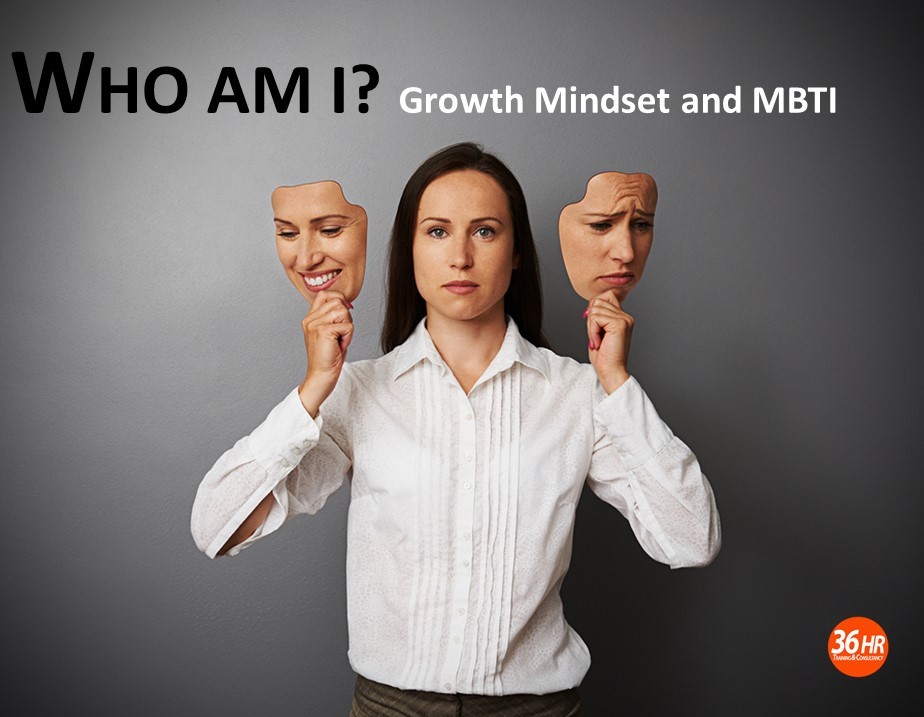
The hardest thing to change is to disrupt ourselves. Do you agree?
contact us for Growth Mindset, MBTI or Personal Branding workshops
Recommended Readings on Growth Mindset vs Fixed Mindset
- Why Having A Growth Mindset Matters To You
- 15 Ways To Develop A Growth Mindset
- How To Maximise Your Personal Development with MBTI and Growth Mindset
- Learning Videos on Growth Mindset and Fixed Mindset
- Why Companies are recruiting employees with a growth mindset
- Why Growth Mindset Should be part of your personal brand
- How A Fixed Mindset Killed Kodak The King of Film Industry
Why Having A Growth Mindset Matters To You

In recent years, the term ‘Growth Mindset’ has become very popular and employers are now looking for employees with a strong growth mindset as part of their personal brand. Companies are seeking leaders with a growth mindset to lead the companies in uncertain times. Many of my clients have also asked me to share more about growth mind vs a fixed mindset.
Do you know that you were born with curiosity and creativity but your experiences in life, school and work can unintentionally mute these qualities. Now it’s time to take control and take it back with a growth mindset.
WHAT IS A GROWTH MINDSET? WHY SHOULD I BOTHER ABOUT GROWTH MINDSET?
First let’s talk about WHY Growth Mindset and what exactly are a “mindset”, a “growth mindset and a fixed mindset”.
Your mindset is the sum of your thoughts and beliefs that determine how you make sense of yourself, your immediate environment, and the world.
According to Dr Carol Dweck, a researcher and Professor of Psychology at Stanford University, there are 2 types of mindsets: a Growth mindset and a Fixed mindset.
Those people with a growth mindset understand that knowledge can be acquired, intelligence and skills can be developed. With a growth mindset, people focus on improvement instead of worrying about how smart they are. They work hard to learn more and get smarter. A “growth mindset,” thrives on challenge and views failure not as evidence of unintelligence but as a great chance to learn and build upon existing skills and abilities. They believe that learning doesn’t stop the moment you leave school or university. With time and effort, their intelligence and knowledge can grow because they recognize that their effort influences their success, so they spend more time practicing or learning, which leads to higher levels of achievement.
As can be seen, adopting a growth mindset is not just essential in your life, it’s critical.
On the other hand, a “fixed mindset” assumes that our character, intelligence, and creative ability are innate characteristics that cannot be changed. People with a fixed mindset only believe that they have been successful when their performance or intelligence measures higher than the standard. They constantly strive for success and avoid failure at all costs because they fear other people will view them as being innately unintelligent.
Having a fixed mindset leads to a belief that intelligence and talent are limited, so there is no use in working to develop or learn. And, because they believe they were born with a restriction on their talent, those with a fixed mindset put this same restriction on their effort– and subsequently, their success.
SUMMARY OF GROWTH AND FIXED MINDSET
To help you understand, here’s a pictorial form of the differences between Growth and Fixed Mindset.
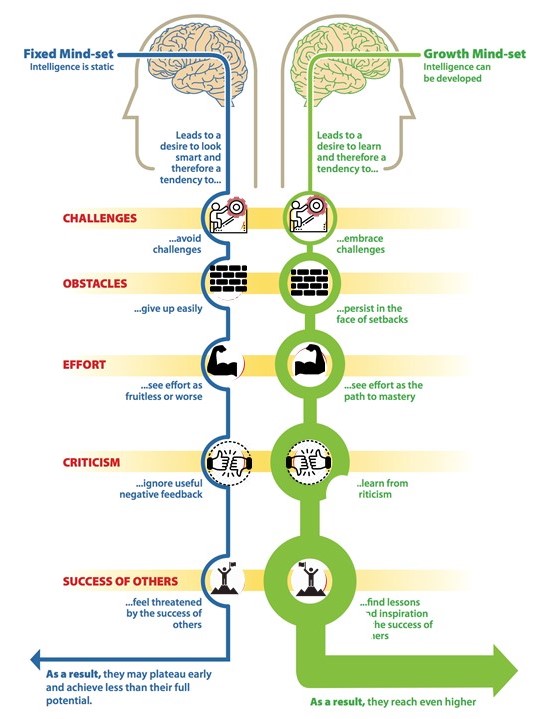
ROLE MODELS OF GROWTH MINDSET
There are uncountable number of role models who practise growth mindset. Just to name a few famous ones
….Einstein’s teacher said that he was ‘academically subnormal’
…..Walt Disney was told that he lacked ‘creative imagination’
….Michael Jordan’s coach said that he wasn’t more talented than other people… Here’s a video of Michael Jordan on his failures and successes. What have you learnt about effort in Michael Jordan’s case?
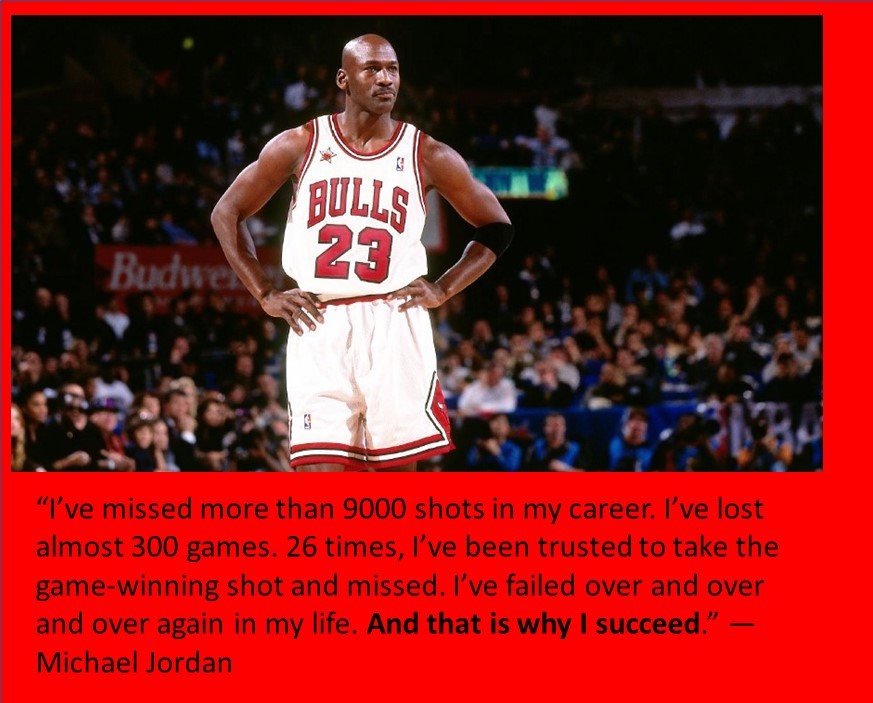
WHAT CAUSED US TO HAVE A FIXED OR GROWTH MINDSET?
Out of these two mindsets, which we manifest from a very early age, comes our belief about whether or not we believe we can succeed at whatever we want to be. We are not what other people said we were at a young age. You might recall in your childhood someone saying to you, “Your composition writing is terrible. You just cannot swim. You are not a good swimmer.” Are they wrong? Did you feel disempowered? Here’s the good news. No matter your current mindset, you can adopt and nurture a growth mindset but you have to work at it.
WHICH MINDSET DO I HAVE?
Some people do have a combination of growth and mindsets, in different areas of our lives and whilst many have a more dominant mindset over the other. Just knowing about the two mindsets can make us think and act in new ways.
CAN I CHANGE MY FIXED MINDSET TO A GROWTH MINDSET?
It is possible to change your mindset from one that is fixed to one that is willing and able to grow. The first step is to recognize your fixed mindset tendencies and beliefs and correct them.
HOW DO I CHANGE MY MINDSET?
Once we can spot the thoughts, words, and actions that go with the fixed and growth mindsets, we start catching ourselves in fixed mode and we can learn to switch into growth mode.
Here are 5 ways you can try to develop the habit of getting into the Fixed Mindset
- Try new things. Experiment. Make mistakes and correct them along the way. Reject what doesn’t work after trying to see what might. Tweak, iterate, and maintain an upward trajectory in effort and progress.
- View challenges as opportunities: Having a growth mindset means relishing opportunities for self-improvement. Learn more about how to fail well. Attack a small challenge until you succeed. Learn how to code or cook.
- Check and change your inner voice: What are your thoughts telling you? Check them for fixed mindset thoughts! And start re-framing your inner thoughts into growth mindset thoughts. For eg, after you have encountered a setback, instead of saying, “I am bad at this”, say “I can improve with effort and practice and I will see results.”
- Stop seeking approval: When you prioritize approval over learning, you sacrifice your own opportunity for growth. Try doing something well at work and don’t tell anyone. Let the recognition come to you.
- View criticism as a positive: You don’t have to use that over-used term, “constructive criticism” but you do have to believe in the concept of being positive leads to learning.
If you would like to arrange for a Growth Mindset/Fixed Mindset workshop or a Growth Mindset lunchtime talk , please contact us to customise based on your requirements. Do share with us WHY you would like to have the talk/course, your requirements and duration. Thank you.
If you find this article useful, please look out for our Growth Mindset resources on:
- Why Having A Growth Mindset Matters To You
- 15 Ways To Develop A Growth Mindset
- How To Maximise Your Personal Development with MBTI and Growth Mindset
- Learning Videos on Growth Mindset and Fixed Mindset
- Why Companies are recruiting employees with a growth mindset
- Why Growth Mindset Should be part of your personal brand
- How A Fixed Mindset Killed Kodak The King of Film
5 Ways To Improve Your Presentation Skills and Become An Engaging Speaker

Welcome To HOW TO IMPROVE YOUR PRESENTATION SKILLS (SINGAPORE) by TK Tan, Public Speaking Coach – Self Help Presentation Skills Training Guide
As a public speaking and presentation skills coach, the most common questions I get asked by leaders, professionals and managers are :
1. How to become more engaging in my presentations?
2. How can I become more interesting as a speaker?
3. How do I lose my nervous energy and gain confidence as a presenter?
(in short, how to overcome my fear of public speaking?)
4. How to improve my presentation skills?
(or how to improve my public speaking skills)
5. How to inspire my audience so that they remember my message and take action?
I have prepared the answers to the above questions through the 5 power tips below.
Presentation Skills Training Tip 1 : Focus On Your Audience, Not Yourself
 Remember that your audience is there to NOT to hear you sell your ideas. They are looking for a solution through the information you present. They are vested in your success and excited about what you have to say IF you what you share is related to their problems and needs. By focusing on them, and what you plan to share, your focus becomes the audience’s needs and not how perfect your diction is or how you sound.
Remember that your audience is there to NOT to hear you sell your ideas. They are looking for a solution through the information you present. They are vested in your success and excited about what you have to say IF you what you share is related to their problems and needs. By focusing on them, and what you plan to share, your focus becomes the audience’s needs and not how perfect your diction is or how you sound.
To prepare and improve on your presentation skills – start researching on your audience. Find out what their deeper needs are. This approach your take answers the questions : How To Connect with the Audience and How Do I Become More Engaging?
Presentation Skills Training Tip 2 : How To Be An Interesting Speaker – Live Life!
For those who want to improve their public speaking skills and become a more interesting speaker, ask yourself – are you an interesting person? Check out this video below on How To Be An Interesting Speaker :
Here comes a VERY IMPORTANT Presentation Skills Tip which many of my leaders, who are coached by me, find useful :
To be an interesting person – be bold, be daring, be adventurous. Are you living life fully? Here’s a very useful tip for you : Make it a point to try a different experience every month – be it helping out at old folks’ homes, or going skydiving. These experiences give you depth and they can be stories you use in your presentations! That’s how you improve as a presenter and public speaker!
Presentation Skills Training Tip 3 : Master Your Rehearsal Techniques
Most presenters when asked, say they spend 90% of time on preparing slides, and remaining 10% on rehearsal and logistics. This is fundamentally flawed, and it clearly shows why people lack confidence.
To answer the question : How To Overcome Fear of Public Speaking? – there are many factors to consider, but the very obvious one is the ‘under-attention’ to rehearsals and practice.
Famous sprinters, swimmers and athletes will tell you that to improve their timing by 1 or 2 seconds means many extra hours and months of practice. Yes, that’s right. There’s no short cut.
When I coach many leaders and presenters on their next public speaking assignment, one of the things I asked them to change is to increase the rehearsal time. Change the ratio from preparation time/rehearsal time to 1 : 9 instead of 9 : 1. You get that?
That’s how you can drammatically improve your presentation skills. Check out the video below on How To Overcome Your Fear of Public Speaking and How To Improve Your Presentation Skills
Presentation Skills Training Tip 4 : How To Improve My Presentation Skills?
Many people who attend my publicly run courses “Dynamic Public Speaking Course in Singapore” and “Effective Presentation Skills in Singapore” – when asked, do not really know what their strengths and weaknesses are.
Whether it is how to overcome your fear of public speaking, how to be interesting as a presenter, how to improve your vocal identity and projection, how to be engaging, how to use pauses, how to improve your executive presence… many are unclear.
You need an unbiased professional diagnosis of your situation so that you need to know exactly what to improve upon in presenting.
Get a public speaking coach to be coached personally, or attend public speaking courses such as those by British Council Singapore, Toastmaster course Singapore, HighSpark Pte Ltd – Presentation Skills Training and Consulting, or Effective Presentation Skills Training Course (2 days) by 36 HR Training and Consultancy. Alternatively, if budget is a concern, get yourself recorded on video and watch yourself. Investing in yourself is the most important investment you make – so you won’t regret!
►►Recommended reading : How To Speak Like Steve Jobs
Presentation Skills Training Tip 5 : How To Inspire Your Audience – Start Telling This!
Do you know that most leaders and great speakers, like President Obama, Steve Jobs – use something that many managers might not, in their speeches to inspire?
A very senior manager I have recently coached mentioned that he prefers to sticks to the facts, as they are clear-cut, and nobody can challenge him. And he won’t go wrong. As a result, his speeches are dry, and matter of fact, with little room to connect him to the audience emotionally. Like him, many speakers might unknowingly deprive themselves on the chance to inspire their audiences.
To inspire your audience, and improve your presentation skills, start telling stories.
That’s right – tell stories. Stories connect you with audiences.
Do you know when you share facts and date, only 2 parts of the human brain are activated and engaged, BUT if you tell stories, 7 parts of the human brain are activated?
In all my Effective Presentation Skills Training workshops and Impactful Presentation Courses, I stress on telling stories. In my personal coaching sessions for leaders and professionals, I stress on telling stories. Get your stories right and you start inspiring your audience.
This article on Self Help on Presentation Skills Training – How To Improve Presentations – is written by corporate trainer, MBTI coach and public speaking coach, Tan Teck Kim (aka TK Tan – he can be reached here)
Recommended Reading : Case Studies of Effective Presentation Course Participants
Look out for more articles on Effective Presentation Training Tips coming your way, here on 36-hr.com
►►If you would like to be coached personally – check out this page on Executive One-to-One coaching on Presentation Skills and Public Speaking
►►If you would like to attend our Public Speaking Course / workshops, check out this page on Effective Presentation Skills Training Singapore or Impactful Presentations Workshop.
Effective Presentation Skills Training Singapore – FAQ
Welcome to our Presentations Skills Training Singapore FAQ Page
 We often received many queries on the Effective Presentation Skills Training Courses in Singapore and Malaysia that we offer. Below are responses you will find very helpful!
We often received many queries on the Effective Presentation Skills Training Courses in Singapore and Malaysia that we offer. Below are responses you will find very helpful!
 1. There are so many Presentation Skills courses in Singapore and Malaysia – which one should I choose?
1. There are so many Presentation Skills courses in Singapore and Malaysia – which one should I choose?
Answer : That depends on your selection criteria. For eg, most courses will train you on presentation structure and some basic body language skills (eg gestures). Most courses focus on helping you present (speak) but we help you to think of yourself of putting up a ‘show’. If you are looking to becoming more confident, more interesting as a speaker demonstrating executive presence, then our Impactful Presentations workshop – Speak So That Others Listen – is the right one for you. Don’t just INFORM but seek to INSPIRE your audience!
2. Is this a Powerpoint Presentation Skills Training Singapore?
Answer : No, but we share with participants a number of useful and practical tips on your visual aids, including powerpoint. We can also customise for you based on your needs, if you are seeking in-house courses.
3. Is this an English Presentation Skills course (Singapore)?
Answer : All our publicly run as well as in house courses are conducted in English. However, the Presentations Skills Training is not a course on English, but a Presentation Course conducted in English. We have separate English coaches for personal coaching.
4. Is this a Business Presentation Course?
Answer: The course covers many areas in Business Presentations as well as Public Speaking.
5. How different is this from the Success With Presentations by British Council or Dale Carnegie Presentations Skills course or the Effective Presentation Skills by NTUC Learning Hub?
Answer : What differentiates us is our experienced trainer who has both practitioner experience in presenting to large and small crowds. Our trainer Tan Teck Kim is also a certified MBTI trainer and many psychological profiling tools. Some presentation techniques incorporate psychology and persuasion so that we train speakers to move from INFORMING to INSPIRING speeches. Tan Teck Kim is a public speaking coach who has provided Public Speaking Courses for Adults, Public Speaking Course for Students, and has coached CEOs, senior managers, professionals and people from all walks of life.
(note : this is not a Toastmasters Singapore course, and 36 HR Training Consultancy is not associated with the Public Speaking Academy)
![]() 6. Does The Effective Presentation Course Singapore cover vocal and voice control?
6. Does The Effective Presentation Course Singapore cover vocal and voice control?
Answer : Our Impactful Presentations workshop covers techniques which help participants to develop a vocal identity, through the use of pauses, pacing, projection and a variety of exercises. It is however not a course on diction. For managers who need to improve on diction/pronunciation, contact us for personal coaching.
7. How large is your audience in your Presentations Training Courses in Singapore?
Answer : for our publicly run Presentations Training courses in Singapore (also known as Impactful Business Presentations) – we have between 6-15 participants – we will cap at max 15 to ensure training effectiveness. For customised in house Presentation Skills training courses – we recommend up to 16 max.
 8. Is this Skills Future Public Speaking course – approved ?
8. Is this Skills Future Public Speaking course – approved ?
Answer : at the moment, many of our participants are from corporations and institutions and hence we are not supported by skills future grant. We offer attractive training discounts to corporates who have more than 10 participants.
9. Why 36 HR Training and Consultancy?
Answer: Clients are spoilt for choices when it comes to training but it makes the decision much harder and slower. Evaluate us based on our experience in real life speaking situations, in training and coaching experience, and what we can customise for you because we recognise that every client is unique. We have :
- more than 10 years of training and coaching experience
- more than 100 training videos for different training scenarios
- more than 50 training exercises including vocal, eye contact and body language techniques
- more than 25 Presentation modules – which you can choose from to customise
- we are training in certain psychological and behavioural techniques which you can incorporate in influencing your audience (not just informing your audience)
- we focus on not just infoming but connecting with your audience.
- a toolkit for you to warmup before every presentation, and many more.
10. How do I get in touch with 36 HR Training and Consultancy?
Answer : Check out our Presentations Skills Training Singapore or Contact Tan Teck Kim (known as TK) via whatsapp by clicking on whatsapp icon below – please state your name, and your email :
How To Overcome Fear of Public Speaking and Give A Great Presentation

1. Public Speaking Training Tip 1 –
Recognise the true source of your fear. Is not knowing what will happen when you are in front of people, giving your speech or presentation? Your fear of public speaking is not that you don’t know your topic. It is the uncertainty of outcome – not knowing what will happen when you step to the podium or stage.
- Most of the time when I coach professionals on public speaking – the most commonly cited fear of public speaking is caused by fear of being judged, making a costly mistake, or the lack of self confidence because of the comparisons with better speakers you see on TV. If you are coming from an authentic place, and you cover the material with clarity and sincerity, you’ve won 75% of your inner battle with fear.

2. Public Speaking Training Tip 2 –
Be Comfortable and Share : Whenever you feel uncomfortable about a presentation, it’s invariably because there’s a slide with something on it that you don’t really believe, or that you’re putting in to achieve a certain result or reaction from the audience. Sometimes you get stuck on phrasing things a certain way so that your listeners will think a certain way. On many occasions, I met many managers ‘inherit’ slides from bosses or colleagues and sometimes are not comfortable with certain messages but they simply keep the old sleek looking slides because the messages sound professional even though they don’t sound right.
- My advice, for those who have attended my Public Speaking Course (in Singapore and Malaysia) and Impactful Presentations Skills Training Workshop (in Singapore and Asia) especially when you’re starting out, is to avoid keeping every slide that you have inherited, and instead adopt the mindset to share rather than to impress. The most important thing is to be comfortable with your material, and to feel like you’re genuinely sharing how you feel about whatever subject it is you’re talking about. The last thing you want to do is to be trying too hard to make sure that you phrase things in just the right way and everything is perfect. When you let go of trying to be perfect, and just try to honestly share what you know it lowers the stress level of public speaking or delivering a presentation immensely.

3. Public Speaking Training Tip 3 –
Spend MORE Time in Rehearsing : Are you one of those who can spend hours and days or weeks to prepare the materials for your presentations or public speaking, but neglect to spend sufficient time on your rehearsals? Perhaps the most important piece of advice I would give to professionals who aspire to improve their public speaking skills is this :
- Don’t be fooled.
A final note: even the best “impromptu” presentations are rehearsed. Mark Twain, as the story goes, was fond of saying, “It takes 3 weeks to prepare a good impromptu talk.” And Winston Churchill, one of history’s greatest leaders and speakers, was thought to spend as much time preparing and rehearsing his “impromptu” remarks as he did on his formal speeches.
In my Effective Presentations Training Workshop, you will learn how to rehearse using power techniques like Key Messages, Verbalisation and Visualisation

4. Public Speaking Training Tip 4 –
Do not be Afraid To Pause frequently. The true story of King George VI reveals that the kind suffers from stuttering. In the movie, “The King’s Speech,” one of the successful strategies the speech therapist deploys to help the king overcome his stuttering is the use of pauses. Pausing helped the king regain his composure whenever he was gripped by anxiety. It is natural to feel anxious when public speaking, therefore do consider pausing more frequently. To reduce your fear of public speaking and improve your public speaking skills – consider a few strategic pauses between key messages to experience a calming effect.

5. Public Speaking Training Tip 5 –
Get Used to the audience expressions – Fast! You will definitely become more anxious when you misinterpret the audience’s facial expression. In daily conversations, we’re used to getting feedback from the listener – an occasional smile or a nod that signals approval. This however is different when are are presenting or public speaking, audiences listen differently. Audiences are more likely to give the speaker an ‘unexplainable’ blank stare, which doesn’t mean they don’t like or disagree with what they hear. More often than not, it simply means they’re focussed on listening to the message. This is especially true of audience members who are introverted. So don’t be too affected by expressionless faces of the audience even when you think you have given your all.

FINAL PUBLIC SPEAKING TRAINING ADVICE :
I have coached many professionals and managers in the areas of how to overcome nerves and fear of public speaking, and to improve their public speaking skills, BUT I have met a greater number of people who kept enquiring for months and took NO action to attend any Public Speaking Courses or Effective Presentations Training (Singapore, Malaysia, Asia). They would ask a long list of questions such as – which is the best public speaking training out there, are toastmasters Singapore courses helpful, who is the best public speaking coach (in Singapore, Asia, Malaysia), how to improve public speaking, are courses offered by British Council Singapore effective for public speaking, how do Presentation Skills Training Courses offered by 36 HR Training and Consultancy compare with Dale Carnegie’s Effective Presentation Skills Training courses, and what are the best public speaking courses BUT after asking for months, they remain exactly in the status quo mode and did not take any action to attend any Presentation Skills Training or Public Speaking courses.

Stop justifying why you should delay overcoming your fear of public speaking. Stop the excuse on why you haven’t progressed in your career because you suffer from stage fright. Take MASSIVE action today to discover :
- how to overcome your shyness,
- how to overcome fear of people
- how to fear of failure
- how not to be nervous about public speaking
- how to IMPROVE your public speaking skills and take your business and career to the next level
Contact Tan Teck Kim, Director of 36 HR Training & Consultancy, Public Speaking Coach (Singapore, Malaysia, Asia) to learn how to overcome your fear of public speaking, and to deliver Impactful and Effective Presentations. Start connecting with your audience, and stop fearing them.
Email : tk36hr@gmail.com
or
Register here for the next Impactful Presentation Skills Training (Singapore) workshop
About Tan Teck Kim, Master Trainer
Tan Teck Kim is trained in NLP, is a certified MBTI trainer and coach, and is also a certified FIRO and FIRO-B Trainer and coach. He helps professionals, business managers, managing directors to differentiate themselves through their personal brand and ability to persuade. He also conducts corporate in house training programmes such as : Communication Skills Training, Effective Presentation Skills Training, Team Building using MBTI, Team Building and Team Bonding.
Impactful Presentation Skills Training – Real Life Case Studies
Welcome To Our Impactful Presentation Skills Training (Singapore and Malaysia) – Real Life Case Studies Series
1. Impactful Presentation Skills Training (Malaysia) Case Study – A Musician
Milton is articulate, suave and smooth as a presenter – reason : He’s a trained musician who performs regularly on stage and hence knows how to command attention. What surprises him is that his audience often couldn’t relate to him – during the July 2015 Impactful Presentations Skills Workshop in Singapore, this is what we discovered when Milton delivered his 3 minute presentation :
- Milton spoke passionately about Taylor Swift, Nicki Minaj, Miley Cyrus, Beyonce and how new music trends are like. The audience could feel his passion but not a single one understood him. The challenge Milton didn’t realise : The audience happened to be in their forties, whilst Milton, a 20-something trained musician, was using a language that never in his mind that others could not understand.

- When I coached Milton one to one on his presentation skills, I suggested that he could consider using terms like Taylor Swift is the Celine Dion of 90s, whilst Beyonce is like the Toni Braxton of the 90s. Milton’s biggest takeaway from the Impactful Presentation Skills Training Workshop is realising that what’s very obvious to him is not obvious to his audience, and when presenting or public speaking, he needs to tailor his language and communication style to suit the audience.
2. Impactful Presentation Skills Training Case Study – A Renovations Company
The directors and staff of a Singapore based renovations company attended the in house customised Impactful Presentations Skills Workshop in Aug 2015. Their problem was how to differentiate themselves from their competitors as they had to present during tenders. Some of the key issues I uncovered for them include :
- Presentation Slides : designed and created by the company’s secretary and not any of the speakers. The slides had over 5 types of fonts of varying sizes and shapes, and some of the fonts are similar to story books of children. The slides had different looks and feel throughout. I advised them to standardize the corporate look and to adopt their corporate (eg logo) colours. I also advised them to use at most 2 types of font, and to adopt fonts that are more commonly used by corporations eg Arial, Tahoma
- Contents : They had endless number of points on multiple slides, which I consider ‘motherhood’ statements – anything that anyone could have dug out from google research, such as “we are very professional, we are trustworthy”…. They was no meaning, nor underlying story to support any of these statements. Anyone could have said those statements and they don’t add any value to the audience. I advised them to carefully contemplate what really made their clients choose to work with them, and why they are successful, and to limit these to about 3-5 points, with supporting evidence and short stories of clients’ work and successes. In short, study and carefully craft out their unique selling proposition with short stories or evidence.
They worked hard at it, and they came back 2 weeks later with another group in house presentation skills training (in Singapore) – their story and their selling proposition was significantly strengthened, and we could then focus on their delivery styles. Their journey to learning how to deliver will be featured in another post in this website.

3. Train The Trainers – Impactful Presentation Skills Training Case Study on Training Company
In 2015, this education company organised an in house Effective Presentation Skills Training Workshop for their training staff – they create materials and train teachers and educators. Most of them are articulate and confident.
Their challenge was how to make it interesting for their audience who are teachers, who are used to taking the lead in public speaking in classes. The advice I shared with these trainers of teachers was :

- Not to just focus on their training materials and contents. Instead focus on their audience problems and find an angle, through their materials, to solve these problems. Only then would the audience be interested. We brainstormed on the problems of these trainers’ audience, who are teachers – and the results were really interesting. For eg, some listed ‘children’ as key issues, whilst others listed ‘parents’ of the teachers as being the source of challenge for teachers. So we discussed ways to resolve common issues relating to parents. That 10-minute segment got my trainers (participants) so excited – it was a good illustration of how as a speaker, I solved their (these trainers’ problem) and gained their respect and attention. The trainers discovered how they (trainers) could likewise use the same technique to arouse interest in their audience (teachers).
For more tips to improve your Public Speaking Skills in Singapore, check out the following articles :
- Learn Public Speaking From Steve Jobs (with Presentation Skills Training Videos)
- 3+5 Ways To Impactful Public Speaking
- 7 Minute Guide To Public Speaking
- 5 Tips To Deliver Impactful Presentations and Speeches
- How To Brand Yourself
- Real Life Case Studies of Participants Who Improved After Attending Impactful Presentations Workshop
- How To Overcome Fear of Public Speaking – 5 Power Tips
Are you seeking to be a more confident presenter so that you can impress the people you want to impress?
Are you hoping to improve your public speaking skills because you have lost many business opportunities?
Are you seeking an in-house customised presentation skills training workshop for your team?

Contact Tan Teck Kim, master trainer of 36 HR Training & Consultancy. He has run public speaking workshops, organised in-house presentation skills training sessions for companies, educational institutions and has trained in asia – including Vietnam, Malaysia, China, Thailand, Indonesia and Singapore. He has trained and coached managing directors, economists, civil service executives, engineers, marketing professionals and housing agents. He is also a trained MBTI coach, MBTI Trainer, FIRO and FIRO-B Trainer and Coach who helps professionals, managers and leaders maximise their effectiveness and communication styles. He also uses MBTI, FIRO, FIRO-B, Colored Brain Communication to help teams and professionals improve communication and enhance communication effectiveness.
Contact Tan Teck Kim today if you too wish to improve your confidence and start connecting with your audience.
Email : TK36hr@gmail.com
Our Presentation Skills Training Methodology : We use presentation skills training videos, provide you with presentation skills training materials (usually in pdf format) Check out one of the many types of presentation skills coaching videos we used during our training workshops :
5 Ways On How To Be An Interesting Public Speaker
Welcome To Our Latest Series of Online Public Speaking Course Tips – 5 Ways To Be An Interesting Public Speaker (by Public Speaking Coach Tan Teck Kim)

Speaking publicly is mankind’s number 1 greatest fear, and many would rather die to speak on stage. Yet, in our careers, we often have to speak publicly or present in front of large audiences. If you have to speak publicly as a job, or as a passion, and are unsure of how you can become an interesting public speaker – the following public speaking techniques and tips, extracted from my Dynamic Public Speaking Course in Singapore (2 days), will help you :
►►Learn From Steve Jobs On How To Improve Public Speaking Skills
►►Tips To Deliver Impactful Presentations
►►How Your MBTI Assessment Can Help You In Your Presentations
Here are additional Tips On How To Be An Interesting Public Speaker
1. Find out what your audience wants – remember WIIIFT – What’s In It For Them.
 Why should they care about what you say? What keeps them awake at night? Make it a point to link your message to their needs. The more you are appear interested in their concerns (and provide a solution to your audience needs), the more they are interested in what you say too!
Why should they care about what you say? What keeps them awake at night? Make it a point to link your message to their needs. The more you are appear interested in their concerns (and provide a solution to your audience needs), the more they are interested in what you say too!
Case Study on Understanding Your Audience - Public Speaking Training Tip
2. Make your audience the STAR!
 Don’t be only focussed on your content – think of your presentation or public speech as making your audience the star. Engage them, connect with them. For eg if you wish to send an email message to your most important client, you do not just click on the ‘SEND’ button. First you must ensure your computer is ‘connected’ to the wifi before you send the message. Likewise, spend time to connect with the audience. One proven way to connect with the audience, as taught in my Dynamic Public Speaking Course (Singapore) is to share stories. Share stories about famous people, or yourself, about a struggle or a problem that was solved. People connect to the emotions of stories, more so than facts.
Don’t be only focussed on your content – think of your presentation or public speech as making your audience the star. Engage them, connect with them. For eg if you wish to send an email message to your most important client, you do not just click on the ‘SEND’ button. First you must ensure your computer is ‘connected’ to the wifi before you send the message. Likewise, spend time to connect with the audience. One proven way to connect with the audience, as taught in my Dynamic Public Speaking Course (Singapore) is to share stories. Share stories about famous people, or yourself, about a struggle or a problem that was solved. People connect to the emotions of stories, more so than facts.
3. Vary something or your mode of delivery every 10 minutes.
 There are too many things that will distract your audience today – whether it’s their unfinished work/email or family issues, or a stock market crash or the next Facebook post about some new virus or bacteria that kills thousands. Your competitors (for your audience’s attention) are extremely tough as they are part of your audience’s habits, whilst you are not. Research suggests that audience attention will fade after 10 minutes. To arrest this ‘problem’, the best way is to vary your mode of delivery every 10 minutes – this eliminates boredom and adds a dose of freshness. Check out these other useful resources :
There are too many things that will distract your audience today – whether it’s their unfinished work/email or family issues, or a stock market crash or the next Facebook post about some new virus or bacteria that kills thousands. Your competitors (for your audience’s attention) are extremely tough as they are part of your audience’s habits, whilst you are not. Research suggests that audience attention will fade after 10 minutes. To arrest this ‘problem’, the best way is to vary your mode of delivery every 10 minutes – this eliminates boredom and adds a dose of freshness. Check out these other useful resources :
►►How To Improve Your Public Speaking Skills & Speak Confidently
►►7 Minute Guide To Impactful Presentations and Improve Public Speaking Skills
4. Here are some suggestions on what you can VARY every 10 minutes when speaking publicly:
To improve your public speaking skills, learn to vary your Eye Contact – most beginners and even very seasoned speakers suffer from a eye contact blindspot, thus unintentionally ignoring a certain segment of your audience. Make it a point to give sufficient eye contact to every one.
In my Dynamic Public Speaking Course (Singapore & Malaysia), I also teach you to develop your executive presence to be an interesting public speaker. You can vary your facial expressions, body stance, gestures, movements, where you stand and how your stand.
In my Impactful Presentation Skills Training Workshop, I teach participants also how to vary their tonality – from pace to volume to using pauses (and yes, SILENCE!).
In my one-to-one personal Coaching on Public Speaking Training and Public Speaking Techniques, I also coach on the use of various media aids – from flip charts to sounds (MP3) to videos to powerpoint. Most people underutilise sounds and videos. Let me for eg show you one of my favourite short videos during my Dynamic Public Speaking Workshop is on why Steve Jobs is such a successful public speaker and how you can be coached on public speaking by watching his video here :
5. Live Life Differently at least once a month
 Finally, to be an interesting public speaker, you can live through different life experiences so that you have more insights to share. One of the most popular tips in my Presentation Skills Training Workshop is :
Finally, to be an interesting public speaker, you can live through different life experiences so that you have more insights to share. One of the most popular tips in my Presentation Skills Training Workshop is :
Make a point to try something different at least once a month – for eg, try that guitar lesson you always wanted but didn’t have the time, or fly to London for the meeting of like minded people to support your favourite footballer. Or dare to hit the gym or the beach for beach volleyball. Maybe it’s helping the needy at social welfare events. Or maybe invest in the next Dale Carnegie High Impact Presentations, or British Council Singapore or 36 HR Training & Consultancy Presentation Skills Training Singapore Course. Whatever it is, build your experiences, think about them, and your insights will grow and make you a more interesting speaker.
Contact 36 HR Training & Consultancy at affordable rates today for an in-house Presentation Skills Training Workshop, in Singapore, Malaysia, Indonesia, China, Vietnam or Thailand, or for the next public run of the Dynamic Public Speaking Course Singapore.
Learn Public Speaking Skills From Steve Jobs

Did Steve Jobs ever attend any Public Speaking Course or Effective Presentations Course? What makes his presentations so compelling that audiences repeatedly crave for more? How did he introduce his revolutionary products with revolutionary public speaking skills?
While even the most skilled and effective presenters simply convey information, Jobs also inspires. He impactfully sells the steak and the sizzle at the same time, as one reader commented a few years ago.
Let’s take a look at his defining 2007 speech when he introduced iPhone and see what we can learn from his public speaking skills. If you are seeking to improve your public speaking skills – you can watch it in full (about 10 minutes) and then later watch bits of the video which relate to various Public Speaking Tips :
Effective Public Speaking Skills – Training Tip 1 :
Start with a quote or statement that causes your audience to ponder. Steve skillfully introduced his speech with this : “Every once in a while, a revolutionary product comes along that changes everything.”
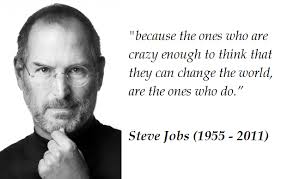
Effective Public Speaking Skills – Training Tip 2 :
Arouse the curiosity of your audience. Steve Jobs skilfully said, “… in 1984, we introduced Macintosh, It didn’t just change Apple, it changed the whole computer industry… in 2001, we introduced the first iPod… and it didn’t just change the way we listened to music. It changed the entire music industry. Well, today, we are introducing 3 revolutionary products.” Impressive isn’t it? That impactful and deliberate public speaking strategy definitely got the audience panting for the new products. Watch the relevant portion of the video here :
Effective Public Speaking Skills – Training Tip 3:
Build in a surprise riddle. Check out the extracted portions of the full video in the shortened video below where Steve built a ‘riddle’ inside his speech without telling his audience. And when the audience are still guessing, Steve did the fourth deadly thing…
Effective Public Speaking Skills – Training Tip 4:
To improve your public speaking skills or deliver an effective and impactful presentation, dare to TEASE the audience. “Are you getting it?” was what Steve Jobs asked when the audience started to realise that the 3 powerpacked new revolutionary features are inside the new iPhone. He did not explicitly say so initially but let the audience slowly conclude for themselves.. how cool a public speaking tip is that?
In fact, Steve Jobs teased the audience again when he suggested having the stylus.. and then he said “yucks”.. That was a classic funny moment we will always remember
[Note : In my public speaking courses (Singapore and Malaysia) and effective presentation skills workshops, I teach participants how to arouse audience curiosity and tease audience with additional tips.]
Effective Public Speaking Skills – Training Tip 5:
Create the WOW factor. It’s a definite compelling buy when audience realised that the only need to pay for 3 revolutionary products for the price of 1!
[Learn multiple ways on how to create that WOW factor for your audience in my Public Speaking Course (Singapore & Malaysia)]
Effective Public Speaking Skills – Training Tip 6:
Make a bold declaration. The ever consummate public speaker Steve Jobs delcared: “Today, Apple is going to reinvent the phone.”
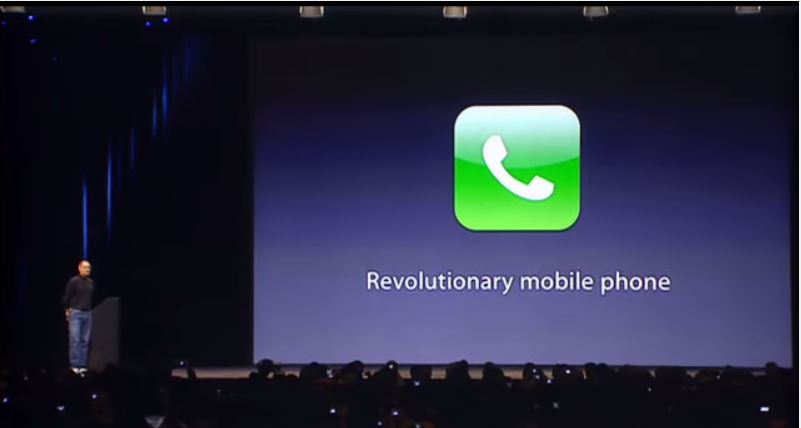
Effective Public Speaking Skills – Training Tip 7:
Solve a MAJOR problem or problems currently not solved. From 3:15 onwards, Steve Jobs spoke of the problems associated with typical smart phones. Then he went on the explain and EXAGGERATE these problems. For eg, he illustrated how not smart a smart phone is, and how not easy it is to use a smart phone. In fact he used about 4-5 minutes to discuss all the inconveniences of the prevailing smart phones.
 Then he summed up what iPhone is : it solves all these problems. So the public speaking trick he used here is to talk about the problems, exaggerate the problems, and then say, hey I solve all these for you.
Then he summed up what iPhone is : it solves all these problems. So the public speaking trick he used here is to talk about the problems, exaggerate the problems, and then say, hey I solve all these for you.
Effective Public Speaking Skills – Training Tip 8:
Use Media effectively and skilfully. Steve Jobs and his slides were totally integrated. His slides illustrated exactly what his message was. His slides carried not long paragraphs but only key messages and pictures. He was clearly the master and the slides were the servant. Many beginners or those who suffer from stage presence tend to hide behind media. To improve your presentation or public speaking skills – master the use of a few types of media (slides, flip charts, sound, videos).
Effective Public Speaking Skills – Training Tip 9:
Exercise your stage presence. Steve Jobs was clearly at ease with the stage – he stationed himself at the side, the centre, and knew when the take the limelight, and when to let his media take the limelight. Did you notice that every hand gesture, leg movement and body movement was calculated to lend weight to what Steve Jobs was saying.
[In my Public Speaking Workshop Singapore (2 days), I share powerful tips to supercharge your body language so that you do not need to remain awkward or shy]
Effective Public Speaking Skills – Training Tip 10:
Rehearse and keep presentation simple. Throughout his speech, Steve kept his contents simple. The construction of iphone was obviously a very complicated research and production process but there were hardly any jargons used. Learn to rehearse with the correct techniques to improve your public speaking skills!

Want to watch the Steve Job’s powerful public speaking skills again? We re-produce the video below :
For more tips to improve your Public Speaking Skills in Singapore, check out the following articles :
- 3+5 Ways To Impactful Public Speaking
- 7 Minute Guide To Public Speaking
- 5 Tips To Deliver Impactful Presentations and Speeches
- How To Brand Yourself
- Real Life Case Studies of Participants Who Improved After Attending Impactful Presentations Workshop
To attend the Public Speaking Workshop (2 days) by 36 HR Training & Consultancy, please click here to find out more :







